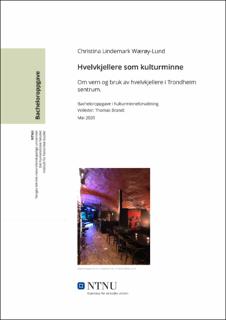| dc.contributor.advisor | Brandt, Thomas | |
| dc.contributor.author | Wærøy-Lund, Christina Lindemark | |
| dc.date.accessioned | 2021-11-03T13:10:02Z | |
| dc.date.available | 2021-11-03T13:10:02Z | |
| dc.date.issued | 2020 | |
| dc.identifier.uri | https://hdl.handle.net/11250/2827640 | |
| dc.description.abstract | Sammendrag
Hvelvkjellere i Trondheim ble i hovedsak bygget for å være brannsikring for byens borgere, og særlig for den borgerlige befolkning. De ble brukt til oppbevaring av gjenstander som var viktige å verne mot brann, men ble også brukt for å oppbevare ulike typer mat og drikke. Oppgaven tar for seg gammel bystruktur fra før 1681 og hvelvkjellernes historie. Det blir også gjort noen sammenligninger på hvelvkjellere i Trondheim sentrum og ute i distriktene.
Det blir redegjort for hvelvkjellerens konstruksjon og hvordan de fungerer som brannsikring og som lagringsplass. Oppgaven tar for seg verneteori og hvordan vi verner kulturminner. Det blir sett på verdiskaping og hvordan hvelvkjellerne kan være med på å skape verdier i Trondheim sentrum. Hvelvkjellerne som eksisterer i Trondheim i dag brukes til ulike formål og det har gjennom tre intervjuer blitt sett på hva de brukes til. I disse intervjuene får vi møte noen av de som driver næringsvirksomhet i en hvelvkjeller og deres opplevelser med dette.
Det blir redegjort for hvilke konsekvenser som kan oppstå hvis det skal foregå rehabilitering eller graving i nærheten av en hvelvkjeller hvis det ikke er gjort tilstrekkelige undersøkelser på forhånd.
Oppgaven tar for seg vern gjennom bruk og om hvelvkjellere har noen særskilt form for vern, og om det er ulike utfordringer med å verne og bruke hvelvkjellere.
Oppgaven er inndelt i seks deler: Teoridel, historiedel, dagens status, hva som er utfordringer og fordelere med bruk og konklusjon. Hver av delene har underpunkter som tar for seg blant annet bakgrunn for bygging, bystruktur, eksempler på bruk i dag, hva som er utfordringer og fordeler ved bruk dem og hvorfor vi skal bevare. | en_US |
| dc.description.abstract | Abstract
Vault cellars in Trondheim were mainly built to provide fire protection for the city's citizens, and especially for the middle-class population. They were used to store items that were important to protect against fire but were also used to store different types of food and drink. This thesis deals with old urban structure from before 1681 and the history of the vaulted cellars. Some comparisons are also made on vault basements in the center of Trondheim and in the districts.
The structure of the vault cellar is explained and how they function as fire protection and storage space. The assignment deals with conservation theory and how we protect cultural heritage. We look at value creation and how the vault cellars can help create cultural and economical in the center of Trondheim. The vault cellars that exist in Trondheim today are used for various purposes and through three interviews it has been looked at what they are used for. In these interviews we get to meet some of those who do business in a vault cellar and their experiences with this.
The consequences of the rehabilitation or excavation near a vault cellar will be explained if there are insufficient investigations done in advance.
The task deals with protection through use and whether vault cellars have any particular form of protection, and whether there are various challenges in protecting and using vault cellars.
The thesis is divided into six parts: Theory, history, todays status, what are the challenges and benefits of use and a conclusion at the end. Each section has sub-points that deal with, among other things, the background for construction, urban structure, examples of use today, what are the challenges and benefits of using them and why we should preserve. | en_US |
| dc.language.iso | nob | en_US |
| dc.publisher | NTNU | en_US |
| dc.subject | Bacheloroppgave i Kulturminneforvaltning | en_US |
| dc.title | Hvelvkjellere som kulturminne - Om vern og bruk av hvelvkjellere i Trondheim sentrum | en_US |
| dc.type | Bachelor thesis | en_US |
